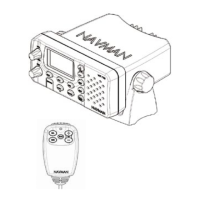
Do you have a question about the Navman VHF 7000 and is the answer not in the manual?
| Power Output | 25W / 1W |
|---|---|
| Channels | All International, USA and Canadian Channels |
| Dimensions | 60mm (H) x 160mm (W) x 170mm (D) |
| Weight | 1.1 kg |
| Waterproof Rating | IPX7 |
| DSC | Class D |
| Battery Life | N/A (Not applicable for fixed-mount transceivers) |
Overview of the NAVMAN VHF 7000/7100 radio's main features and capabilities.
Guide to personalizing VHF radio settings for individual preferences and usage.
Instructions for accessing and navigating the radio's menu system and options.
Procedure for inputting text and numbers using the radio's controls.
Explanation of icons and symbols displayed on the VHF radio's LCD screen.
Details on fundamental operations and the functions of each key on the radio.
Overview of the available options within the radio's main menu structure.
Instructions for managing the buddy list, including adding, editing, and deleting entries.
How to adjust radio sensitivity for local or distant reception conditions.
Settings for adjusting LCD backlight and contrast levels for optimal viewing.
Configuration of GPS position and time data for the VHF radio.
Options for displaying Course Over Ground (COG) and Speed Over Ground (SOG).
Setting up GPS alarms for receiver disconnection or other issues.
Instructions for using the GPS simulator feature for testing purposes.
Procedure to restore all radio settings to their original factory defaults.
Overview of the radio setup options for configuring the device.
Guide to editing or removing custom names for radio channels.
Adjusting the volume levels for incoming call notifications and system beeps.
Enabling or disabling internal speakers for audio output.
Configuring the priority channel for scanning and dual watch functionality.
Activating and receiving weather alerts from NOAA broadcasts.
Configuring NMEA protocol for communication with other instruments.
List of available options within the DSC setup menu for Digital Selective Calling.
Procedure for entering the unique Marine Mobile Service Identity for DSC functions.
Managing groups of contacts for DSC calls, including creation and editing.
Setting up ATIS functionality and MMSID for inland waterways in Europe.
Enabling or disabling the DSC scanning functionality on the VHF radio.
Configuring how the VHF radio responds to incoming LL requests.
Introduction to Digital Selective Calling (DSC) and its role in maritime communication.
Detailed steps for initiating various types of DSC calls to other vessels or stations.
Procedure for making a standard individual DSC call manually.
How to access and redial the most recent incoming DSC call.
Initiating DSC calls to pre-defined groups of contacts.
Sending DSC calls to all vessels within range, with options for priority.
Making calls from the log of received distress calls.
Information on how the radio receives and displays incoming DSC calls.
Procedure for handling incoming 'All Ships' DSC calls.
How to receive and respond to incoming DSC group calls.
Step-by-step guide for initiating a DSC distress call in an emergency.
How to handle incoming DSC distress calls, including alerts and voice contact.
List of international VHF marine channels with frequencies and usage.
List of USA VHF marine channels, including frequencies and traffic types.
List of Canadian VHF marine channels, detailing frequencies and uses.
List of European Community (EC) VHF marine channels and their specifications.